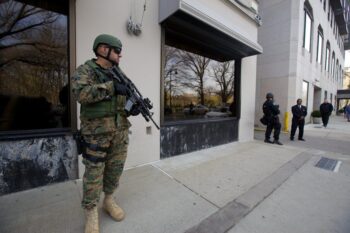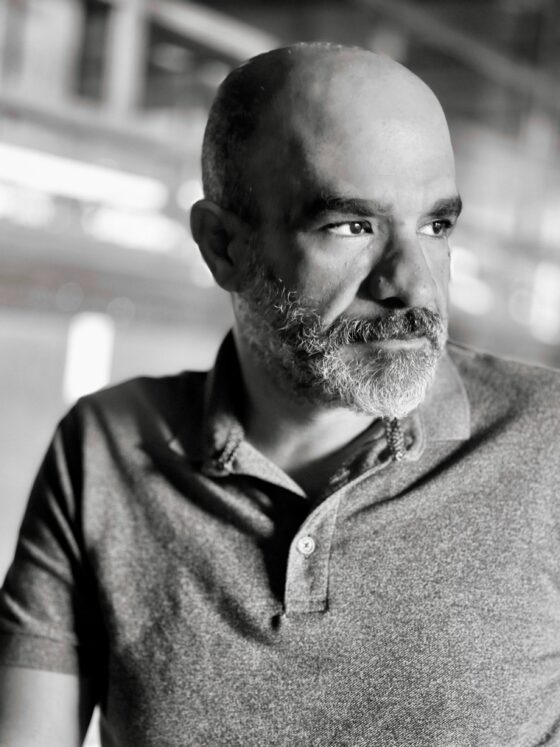
I was walking out of MIT’s gym at 11 pm when the loudspeaker came on, telling us that there was a gunman on campus and to shelter in place. I kept walking. Campus security had been on edge ever since February, when someone phoned in a report of a person walking through the Main Group building with a long rifle and body armor. S.W.A.T. teams converged on the school to discover that the report had been a hoax, a possible salvo over the suicide of Aaron Swartz. I had no time for more fairytale gunmen.
I biked home down Massachusetts Avenue. The air smelled like rain and the lights of a police motorcycle blocking off Vassar Street flashed blue on the wet pavement. A helicopter drifted overhead, closer to the ground than I’d ever seen, and then another one. Something was off. The cars around me drifted from lane to lane like boats that had lost their bearings. I could hear sirens coming from all directions, converging on this point. I kept biking.
 I would be home before I learned that Sean Collier, a goofy, much loved, campus police officer was already dead, shot less than a block away from the intersection I had just biked past. The brothers who shot him, Dzhokar and Tamerlan Tsarnaev, had already hijacked a Mercedes SUV and fled. I would be home before I learned that two of my roommates, working late on campus, had followed shelter in place directions and locked themselves into a windowless room with the lights turned off. They would stay there until 2:30 a.m., and return home with another student too terrified to go back to her apartment alone.
I would be home before I learned that Sean Collier, a goofy, much loved, campus police officer was already dead, shot less than a block away from the intersection I had just biked past. The brothers who shot him, Dzhokar and Tamerlan Tsarnaev, had already hijacked a Mercedes SUV and fled. I would be home before I learned that two of my roommates, working late on campus, had followed shelter in place directions and locked themselves into a windowless room with the lights turned off. They would stay there until 2:30 a.m., and return home with another student too terrified to go back to her apartment alone.
I had written a letter to a friend earlier that day wondering if the bombers felt some sense of accomplishment in killing an eight-year-old, a grad student in statistics, and a restaurant manager who loved sports and her dog. In what story was this heroic?
The three deaths at the marathon felt miscast, and so did Collier’s. He was a classic small-town cop, so friendly that his policing blurred the line between “policing” and “hanging out.” He went on student camping trips, unlocked doors and led students onto roofs to see forbidden views. The story set into motion by the bombers was dramatic but the characters weren’t. This was a school pageant: intensely felt but poorly written. Now we were a part of it. The townspeople whose fear would be the necessary backdrop for the heroics of others.
I woke up Friday morning to the sound of helicopters and birdsong. Everything else was silent. No cars. No sound of squealing children from the school down the street. Noisy, obstreperous Boston had ground to a halt on account of one 19 year old. The Boston Globe reported that police were handcuffing people found wandering outside. We stayed put.
At one point I stood on the lawn, talking to another roommate who was weeding the garden, and looked over to see our neighbors staring at us through their window. We waved. We’d met them during the big snowstorm a few months ago. Like today, the city had ground to a halt, but the neighborhood was alive with skiers and snow forts and neighbors shoveling their sidewalks.
The neighbors turned away from the window. They didn’t wave back.
It was a day of contradictions. The schools were closed. The Dunkin’ Donuts were open, at the request of the police department, who had a history of receiving free donuts and coffee from the chain. I turned to the internet. Would it even have been possible a few years ago to shut down a city without a thing like this: something that made us feel so connected without actually being near each other? I, along with hundreds of other people, found Dzhokar Tsarnaev’s Twitter account. “I really don’t like it when I have one ear pressed against the pillow and I start to hear my heart beat,” he wrote. “Who can sleep with all that noise.”
His last post, two days after the bombing and a day before the death of Sean Collier read, “I’m a stress free kind of guy.” Humans of the present day posted replies to the Dzhokar of the past. “When you’re not terrorizing,” wrote one, “sure…why not?” “After he’s found guilty,” wrote another “he should die by pressure cooker.”
The curfew was lifted at 6pm, as though the city had put in a full workday of staying put, and was now free to enjoy the weekend. A few minutes later a Watertown resident named David Hennenberry walked outside for the first time that day. He saw that the tarp covering the boat parked in his driveway was blowing in the wind. The cords holding it down were cut. Hennenberry looked inside and saw a pool of blood and a figure huddled in the shadows. He called the police.
And with that the ordinary people of Boston and Cambridge had a role in this story beyond that of “victim.” A metropolis of 625,087 sheltering in place while thousands of police combed the streets and searched houses, and it turned out that we were more useful outdoors than in.
After 9/11 America became a fussy and overprotective parent, tapping phone lines, shutting down protests, classifying documents, scrutinizing visitors and immigrants as if daring them to do something wrong. To deal with crisis, to recover from trauma, to absorb uncomfortable and complicated information. America does this, we are told, to keep us safe.
But this has never stopped us from saving each other. The passengers on American Airlines flight 63, who stopped a man from detonating the explosives he’d packed into his shoes by tying him up with their seatbelts and headphone cords. Or the passengers on United Airlines Flight 93, who broke through the door of their hijacked plane by using food cart as a battering ram.
These stories have faded in American history in comparison to the tragedies that came before and after them. But if we have the presence of mind to remember it, and to keep remembering it, the end of this manhunt was another vindication of the average Joe. Also: for being in the world, instead of being protected from it.
The police arrived in Hennenberry’s accompanied by a helicopter equipped with a thermal camera, and a robot. The helicopter flew over the boat and confirmed that there was a living body inside, or at least something warm and human-sized. The robot trundled over to the boat and pulled off the tarp, so that they could get a better look inside.
The police yelled to Tsarnaev to get out of the boat. They weren’t sure if he was armed, and so they shot at the boat, and threw flash-bang grenades. When Tsearnaev finally stood and pulled up his shirt to reveal that he wasn’t wired with explosives, they moved in. He was unconscious at this point, and the Department of Justice stepped forward to reveal a new twist to the story that engrossed us for so many hours. When Tsarnaev recovered, he would not be read his Miranda rights.
“There will always,” a friend of mine said to me that day, “be a man with a gun.” And there will. But the man with a gun is just another character in a story, and that story is one that we, as a country, write together.
***
Top photo by Vjeran Pavic. Second photo by Brian Birke.




